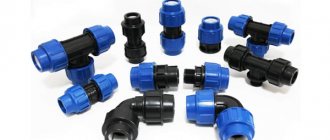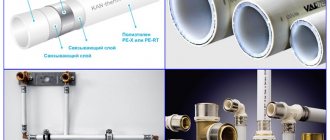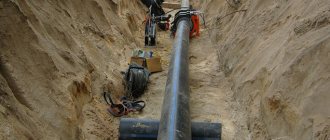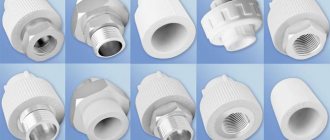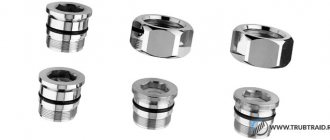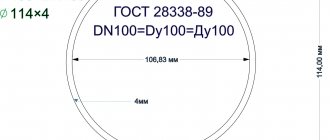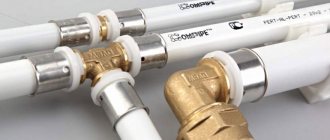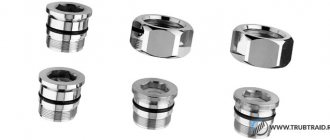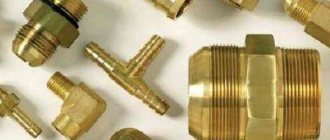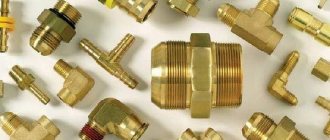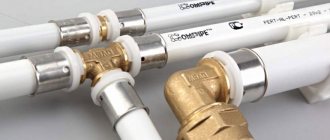The arrangement of utilities with the laying of steel pipelines of various configurations cannot be performed without the use of connection parts.
Before you begin calculating the system and assembling it, you need to understand what fittings for steel pipes the modern market offers and how the parts are installed, don’t you agree?
We have prepared a detailed review of pipe fittings for making detachable connections, provided recommendations for the selection of elements, and also described the specifics of their application. Step-by-step instructions for installing a threaded fitting and a ferrule will help you assemble a pipeline without the involvement of specialists.
Features of fittings
The standard sizes of steel parts for connecting pipes presented on the modern construction market cover the entire line that can be used in projects for transporting working fluids. The diameters of steel products can be expressed in millimeters (mm) - meter series or inches (inch, in or ″). Outer diameters and sizes range from 3.2 mm (1/8") to 123.8 mm, which is 4 and 7/8 inches, respectively.
Advantages
The main advantage of steel connecting elements is their wide range and steel strength. By using various parts in the pipeline, you can easily achieve both the required angle of rotation of the pipe and the organization of the branch.
Using the necessary elements, you can change the diameter of the pipeline and organize a plug. Installing pipeline fittings using connecting parts will also not cause difficulties.
The advantages of these products include the ability to choose according to the type of connection to the pipeline:
- welding or threading;
- crimping method;
- connection using press techno or flange connection.
Flaws
The disadvantages of steel products include:
- Heavy weight. With large volumes of work this will be felt.
- Insufficient plasticity. A property that is absent in polypropylene pipes and parts for their connection.
- Susceptibility of steel to corrosion. The use of anti-corrosion coatings allows us to reduce negative consequences to a minimum.
Service life, perhaps, could be one of the disadvantages, but taking into account other components of pipelines and materials, it most likely is not.
What fittings are used for PVC structures?
Most often, plastic pipes reinforced with fiberglass are used for water supply systems. Of course, in order to connect them together, fittings are used.
Plastic pipes and connecting elements for water supply
Prices for plastic pipes
Plastic pipes
In most cases, elements with a diameter of 20 to 40 millimeters are used, because elements with a larger cross-section are generally suitable only for industrial systems. To install pipes in an average apartment, fittings with a cross-section of 20 millimeters are often used.
Purpose of fittings for plastic pipes:
- Clutch. As we have already said, this is the most primitive connection, which has the shape of a barrel. Pipes are inserted into the internal space of such an element on both sides.
- Adapter. This element is similar to a coupling, the only difference is that each side has a different diameter, so it will be possible to connect structures with different cross-sections. They are often used when installing a heating system.
- Corners. Connected to the pipe by heating. It turns out that one part is inserted into another. These elements are used if it is necessary to connect pipes at an angle.
- Elements with three outputs. They are used when it is necessary to route water pipes in different directions.
- Collectors. They are required in order to distribute water, so there are shut-off valves at their ends.
- American. This is also a coupling, only in this case it has a modified appearance. On one part of it there is a thread, and on the other end of the pipe for connection by soldering.
- Contours. Installed in places where the pipeline intersects.
PVC fittings
Despite the fact that some connections are intended for pipes made of different materials, it is still recommended to use elements from the same material during installation. So, if you chose polypropylene pipes with fiberglass reinforcement, then the fittings must be appropriate.
Depending on the location and method of application, plastic connections are of the following types:
- smooth;
- y-shaped;
- T-shaped.
In addition, in this case, both crimped and welded elements are also used.
Among the advantages of compression plastic fittings, it should be noted:
- ease of installation;
- ready-made elements are used, so the use of special devices is not required;
- no need to purchase a welding machine;
- such compounds have better resistance to high temperatures and other influences.
Welded fittings are connected using a butt welding machine. However, they can only be used if a water supply is installed.
Welding polypropylene pipes and fittings: step-by-step instructions
Step 1: the first thing you need to do is screw the nozzle of the required diameter onto the device. Here you should use the hex key included in the kit.
You should unwind the elements and then tighten them on both sides on the welding machine. Moreover, this will have to be done before it heats up.
Step 2: Next you need to turn on the device, while paying attention to the temperature regulator. On average, 250-260 degrees are required to securely connect the parts
Set the temperature and wait 15 minutes
Step 3: Now the pipe and fitting should be placed into the nozzle on both sides.
These elements should be secured securely. On average, heating time lasts 6 seconds
After connection, it is important to carefully inspect the pipe and fitting to eliminate defects. In addition, you will need to leave the structure for about 30 minutes and then continue installation
Types of fittings according to shape and purpose
The selection of products should be carried out in accordance with the pipe material and installation features. Couplings are used to connect pipes: elbows - for turning them, tees - for connecting a branch.
coupling
Used to connect pipes in one direction. In this case, a steel coupling with an internal thread is used.
Bend (angle)
Bends, or elbows, are necessary for smooth rotation of the pipeline. Standard bend angles are 30, 45, 60, 90 and 180 degrees. The exception is bent bends, which can change the direction of the pipe at any angle in the range from 1 to 90°.
Tee
Tees allow you to organize branches from the main pipeline. Tees can be equal or transitional. For an equal tee, the diameter of the main line (main direction) is equal to the diameter of the branch. The transition tee connects a smaller diameter pipe to the main line.
Prices for tees for steel pipes
Tee for steel pipes
Cross
A product that separates the flow of the working medium in four directions. Other uses for this product are possible. A crossbar can connect two incoming secondary streams into a third. Like a tee, a cross can have branches both equal to the diameter of the main and different from its diameter. Depending on the method of connection to the pipeline, crosspieces can be either threadless - welded, or with threads (internal or external).
Adapter (transition)
Adapters are designed to connect pipes of different diameters. Adapters (in other words, transitions) can be concentric or eccentric in design. The difference in the design of concentric and eccentric transitions is in finding the line of the center of the pipeline. For concentric transitions, the center is the same for both diameters. In the design of an eccentric transition, the center lines of the larger and smaller diameters are at different levels.
Union
The fittings are used to connect control and measuring equipment. And its simplest purpose is to connect flexible hoses. The threaded part of the fitting is screwed into the pipe, and a branch pipe (hose) is put on the “herringbone”. The stepped structure prevents the hose from coming off. The standard sizes of fittings are usually encrypted in their designation.
Stub
A plug, as a pipeline element, is needed to close the end of the pipe. In this way the system is sealed. Plugs of small diameters are made with threads. The diameter of the plug depends on the diameter of the pipe. Consequently, plugs are distinguished with standard sizes based on internal and external diameters. Stamped plugs can be elliptical or flat.
There are other products - specialized ones, their modifications and hybrids. Hybrids are rarely used and, as a rule, are made to order.
Advantages and disadvantages
We list the main advantages of crimp connectors:
- the ability to quickly assemble and disassemble the connection;
- simplicity and high speed of installation, which is important in emergency situations;
- tightness of the docking unit;
- a wide selection of products in different configurations and diameters.
However, the clamping elements have the following features:
- they do not like mechanical influences: a weak blow is enough and the unit may lose its tightness;
- not designed for high pressure;
- rubber gaskets quickly lose their characteristic qualities at high temperatures, which inevitably causes leaks;
- The connection mechanism of the clamping coupling weakens over time; the fastenings must be regularly tightened.
Types of fittings by installation method
The catalog of connections according to the methods of installation with the pipeline includes:
- welded;
- threaded;
- crimping;
- flanged;
- press fittings.
The video shows a pipe press fitting.
Welded
Such parts are attached to the pipe by welding. A nuance that should be taken into account when purchasing welded elements is the processing of the edge for welding. On small diameters, this edge makes a right angle (90°) to the surface of the pipe. For products with a diameter of 50 mm and a wall thickness of more than 4 mm, the welding edge may be different.
Threaded
Such connections allow you to dock water supply, heating and gas pipelines using installation tools. The thread of such elements can be metric or inch. This must be taken into account. But it is important to remember that these products must be of high quality.
Parts with connecting threads from leading manufacturers are supplied with gasket materials. The use of gaskets avoids leaks.
Prices for threaded fittings for steel pipes
Threaded fitting for steel pipes
Crimping
Compression fittings for steel pipes are used in conditions where the use of welded products is contraindicated by the production technology. A special feature of this type of installation is the presence of sealing rings (4), clamping rings (3) and clamping rings (2) in the structure.
Flange connection elements
A special feature of this connection is that the elements are connected to each other using studs or bolts. The advantages of this connection of pipeline system elements are the ability to quickly replace a problem section of the pipeline without using a fire method (welding) or mechanical impact (cutting with a pipe cutter or grinder).
The flange fitting kit includes:
- studs or bolts according to the number of flange holes;
- nuts;
- sealing gaskets.
Press fittings
The main feature of the use of pressed elements in pipeline construction is the availability of specialized tools for installation. This is both an advantage and a disadvantage of this type of connection. But construction and installation professionals are confident that with the right approach and organization of work, there is no faster way than this.
Press technology is the fastest method of installing pipeline systems. There is only one limitation - the large diameters of pipes and pipe parts. Professionals do not take into account the high cost of a set of tools, since it is more than compensated for by the high speed of work.
Application area
Compression (another name for a pressure fitting) connector is used in communications for various purposes:
- private house;
- multi-storey buildings;
- utility networks;
- industrial pipelines.
They are convenient for installing joints in corners, on branches, and when joining channels of different diameters. The device is indispensable when repairing pipelines when the threads in the connections rot and it is not possible to re-cut them.
If press fittings create a permanent connection, then crimp fittings allow you to quickly disassemble the unit and carry out repair work, which is a big advantage.
Using clamping elements, not only metal, but also metal-plastic channels are mounted. The connectors can withstand any working environment: hot steam, water, gases, oil products.
The design and installation of crimping devices is described in this video:
Types of fittings by material of manufacture
Metal connecting elements are made of the following main steels and alloys:
- steel;
- Cink Steel;
- brass;
- copper.
Steel connecting elements
Parts made of steel of various characteristics and composition, including stainless steel. The most common type of connecting elements for pipelines of various categories. They are used both in chemical storage systems and in other industries. In the chemical and petrochemical industries, compounds made from stainless steel grades are used.
Galvanized steel pipeline parts
Galvanizing of pipeline elements is used to additionally protect systems from corrosion. Diesel diesel engines made of galvanized steel have an increased service life. In addition, after applying the zinc coating, use in aggressive environments becomes possible.
Brass
Brass, as a two-component or multi-component alloy, has a number of undeniable advantages. Brass is not subject to corrosion and has good anti-friction properties. In addition, it has virtually no contraindications for mechanical processing. The temperature of the working medium in brass pipelines can reach 200ºС.
Copper
Such parts as part of copper pipelines have a number of advantages that are not available for other materials. This is a complete absence of corrosive effects, exceptional thermal and electrical conductivity. The service life is 100 years, and even more under appropriate external factors. Copper is a very ductile material.
The advantage of copper is its resistance to changes in temperature conditions. It is not exposed to chlorine and other chemically active substances. This means that such diesel engines are used in pipelines of chemical plants. The main disadvantage of copper products is their high cost.
Cast iron
Parts for connecting pipes made of cast iron are distinguished by high strength. Products made of cast iron are highly resistant to mechanical stress. They are used as part of pipelines transporting hot and cold water.
Just a few years ago, such parts were the only elements of pipeline systems available for purchase. However, even now these connecting elements are not considered a relic of the past; they are widely used in the national economy.
Application of plastic pipes and fittings in water supply
Polyethylene pipes are the most common when creating water supply systems. The products have a smooth surface, which prevents impurities from depositing on the walls. The only drawback of polyethylene pipes is that they can only be used when creating a cold water supply system. If a line for hot water is laid, products made of cross-linked polyethylene are used, which are characterized by increased strength and resistance to high temperatures.
The water supply system is installed using connecting elements - fittings. When using polyethylene products, it is possible to create engineering systems without the use of complex equipment. This solution reduces installation labor costs and reduces waste.
Threaded fitting installation technology
For long-term operation of a pipeline system, the method of installation of elements of which is a threaded connection.
The following procedure and recommendations must be observed:
- Prepare the element for joining. To do this, it is necessary to check the integrity of the element itself and, most importantly, the condition of the thread.
- Seal the thread. Various sealing materials can be used. For example, Tangit Unilok thread or FUM tape.
- Tighten the connection and make sure it is secure. Fixation must be 100%, without degrees of freedom.
- If necessary, carry out additional treatment with surface sealing materials.
- Check the piping system for leaks.
Nuances of installing a crimp coupling
The threadless connection eliminates the use of welding. All that is needed to install the coupling is the keys.
The technology is as follows:
- Secure the clamping nut.
- Assemble the collapsible element. To do this, install the seal, clamping and pressure rings and tighten the nut.
- Tighten the nut on the ferrule body.
- Make sure that the rings are securely clamped inside the coupling.
A compression coupling is also called a compression fitting.
Prices
Cost comparison table for nominal diameter DN 20.
| Name | Marking | DN | Country of manufacture, price, Russian rubles |
| Bend (angle) | Square 90-1-20 | 20 | 18,75 |
| Tee | Tee 20 | 20 | 45,60 |
| Cross | Chug cross. 20 | 20 | 63,52 |
| Adapter | Adapter cast 32x15 | 32x15 | 44,00 |
| Union | Nickel-plated brass fitting DN20, hose coupling, d20 mm | 20 | 82,12 |
| Brass plug | Brass plug 20 fitting | 20 | 31,80 |
| coupling | Cast iron coupling short 20 | 20 | 17,50 |
You can buy fittings for steel pipes in online stores of companies selling pipeline fittings, in a regular plumbing store, or in city building materials markets.
There are many manufacturers of steel pipeline elements on the market, both domestic and foreign. The leadership in this industry belongs to the PRC. Their products are the most affordable. But the quality of too cheap products leaves much to be desired. The advice of professionals is simple - stick to the golden mean. Read about fireplaces with a water circuit on the website.
